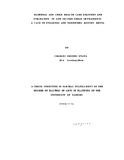Maternal and child health care delivery and utilization in low income urban settlements: A Case of Nyalenda and Pandipieri, Kisumu, Kenya

View/
Date
1993-06Author
Oyaya, Charles O
Type
ThesisLanguage
enMetadata
Show full item recordAbstract
Health care services are among the public services that profoundly affect
human well being. The provision of health services therefore need to
demonstrate sensitivity to social, economic, cultural, environmental and spatial
components which influence the configuration of health care systems and
personal health behaviours. The scarcity of health care services in urban areas
has been exacerbated by rapid population growth and lack of planning for such
rapid increases resulting in high demand for health services, problems of
housing, sanitation, pollution and family dislocation. The intra-urban patterns
of accessibility to health care have hence shown a general picture whereby the
poor people and poor neighbourhoods suffer some disadvantage. This finds
expression in the urban structure and its constraining effects on locational
decisions.
The study sought to examine the factors which affect the delivery and
utilization of maternal and child health care services in the low income urban
settlements and their implications on planning of health services for the urban
poor. It is demonstrated that while the greatest attention of health care should be
directed to the poor and those who can not afford to compete effectively in the
market place of health care, it is most unfortunate that the urban slums receive
the least attention from policy makers and health planners. It then follows that
these settlements are often subjected to untold environmental insults, insecurity
and poor infrastructural base for the delivery of primary health care. In this
situation, the worst hit are the women and children who constitute over 60% of
the total urban population. They are in turn subjected to suffer from multiplicity
of health problems which are otherwise preventable.
The author critically analyses the theoretical formulations in literature which
govern the delivery and response to the health care interventions provided.
These include issues of public health policy, health education, family planning,
the role of hospitals in MCH/FP delivery, community participation in the health
care delivery process. Also critically reviewed are the the Health Belief model
and Health planning approach which provided the theoretical framework Oil
which the study was based. Out of the inadequacies of the two models, the
author empirically formulated an alternative model to explain further the
interplay of various factors at different levels in affecting the delivery and
utilization of health care in low income urban settlements.
Both primary data and secondary data was collected. The primary data
was obtained from 80 household respondents sampled using the cluster
sampling technique and the key informants whose choice was based on non
probability sampling technique. Of the techniques used, the use of
questionnaires and participant observation proved the most valuable. Various
descriptive and inferential statistics were performed including percentages,
averages cross tabulations and chi square. The data is graphically presented
using bar graphs and pie charts.
The main body of the work presents the analysis of the general health
determinants in the study area and the factors influencing the delivery and use of
MCHlFP services. The author argues that poor health status of the people living
in the low income urban settlements of whom the majority are women and
children, result from a combination of both structural and situational factors. III
the examination of factors, financial resources, formal education, functional
efficiency of health facilities and location were found to exert a lot of influence
on the provision of MCH/FP services and therapeutic behaviour of users.
It is therefore recommended that greater attention should be directed on the
adoption of an integrated and comprehensive approach to the planning of health
care services including the provision of health education, public health
infrastructure such as sanitation, motivation of health workers and the
recognition of traditional health systems by the health policy.
Citation
Degree Of Masters Of Arts In PlanningPublisher
University Of Nairobi
Description
A Thesis Submitted In Partial Fulfillment Of The
Degree Of Masters Of Arts In Planning Of The
University Of Nairobi
